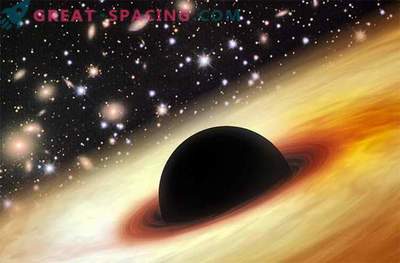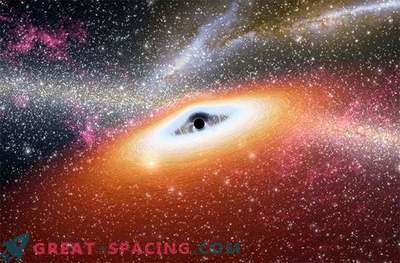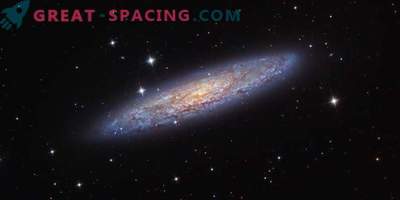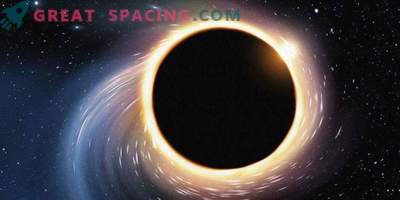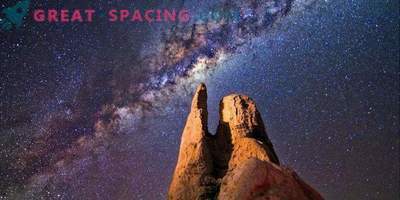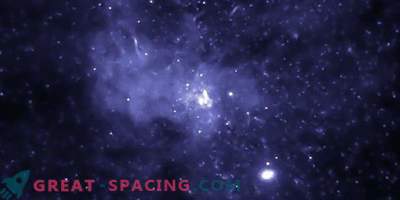
Astronomers have discovered a rather strange discrepancy in the center of a distant galaxy - it contains two supermassive black holes, but one of these black holes is “naked” and surrounded by only a few stars. In contrast, the sister of this black hole just buzzes from a cluster of stars.
This discovery, according to observations of the Hubble Space Telescope and the NASA Chandra X-ray Observatory, made astronomers wonder: why do some black holes have a cluster of stars surrounding them, while others are deprived of it? In addition, how does this contrast affect the evolution of a black hole and how does this affect the evolution of entire galaxies?
As Discovery News reports, earlier this week, the first key to the odd difference in SDSS J1126 + 2944 is that this particular galaxy is the result of a galaxy merger. Mergers occur when two (or more) galaxies collide and fall into the trap of their mutual gravity well. Some stars are scattered in a dramatic shock, but for the most part, the stars mix and then settle (gain their place). (It is believed that massive galaxies like the Milky Way are in fact disassembled remnants of many small galaxies).
After all, supermassive black holes, which are believed to hide in the nuclei of most galaxies in the universe, can merge themselves, creating super-supermassive black holes. This is the inevitable part of the growth of a black hole in the evolution of galaxies.
But in the case of SDSS K1126 + 2944, the two black holes are still at some distance from each other and were presented in a new study this week at the American Astronomical Society (AAS) during the Kissimmee, Florida, meeting and published in the Astrophysical Journal. Researchers threw all their strength to understand why one of the black holes has a population of stars - a feature that will undoubtedly affect its supply of falling matter. “One black hole starved, and has 500 times fewer stars associated with it than another black hole,” said lead researcher Julie Comerford, Colorado, Boulder University. “The question is why there is such a discrepancy.”
Comerford believes that there are two possibilities. First of all, during the confluence of two galaxies, tidal and gravitational forces broke off the neighborhood of the black hole and scattered the surrounding stars. But there is another rather curious explanation that can fill the gap in our knowledge of how black holes grow.
In astrophysics, we know that mostly black holes have from 5 to 100 solar masses, which remain behind after a massive star goes to a supernova and we are familiar with “supermassive” black holes in galactic nuclei that have a mass from a few hundred thousand to millions (or even billions) of solar masses. You may have noticed that there is a huge mass gap between these two types of black holes. If black holes start from small sizes and grow more massive over time, what types of black holes form a bridge between the black hole stellar mass and supermassive monsters?
Astronomers were looking for “intermediate masses” of black holes (IMBHs) to fill this gap, and knowing the prevalence of stellar mass and supermassive black holes, there must be a lot of IMBHs. Mostly the average black holes in their path become supermassive. But there are only a handful of candidates and this is just weird. If our theories of the evolution of a black hole are correct, we should not have difficulty in tracking intermediate black holes that fall in the mass range from 100 to a million solar masses. Are their outliers just difficult for us to understand? Or lack of observational data is the key to their rarity? Intermediate masses of black holes are too massive to form when exploding massive stars, so they are likely to be objects that slowly formed as a result of black hole fusions and mass accretion processes over billions of years. Some observations of the low luminosity of active galactic nuclei and the detected ultra-luminous X-ray sources (SRI) in neighboring galaxies are also important clues to this issue. In addition, it is believed that dwarf galaxies contain intermediate mass black holes in their nuclei. Dwarf galaxies have a lower density than stars in more massive galaxies.
Could it be that a “naked” black hole in SDSS J1126 + 2944 is actually an intermediate mass of a black hole that originated inside a disassembled dwarf galaxy?
“The theory predicts that intermediate black holes should exist, but they are difficult to determine because we don’t know exactly where to look,” said co-author Scott Barous, also from the University of Colorado, Boulder. “This unusual galaxy can provide a rare opportunity to look at one of these intermediate masses of black holes.”


